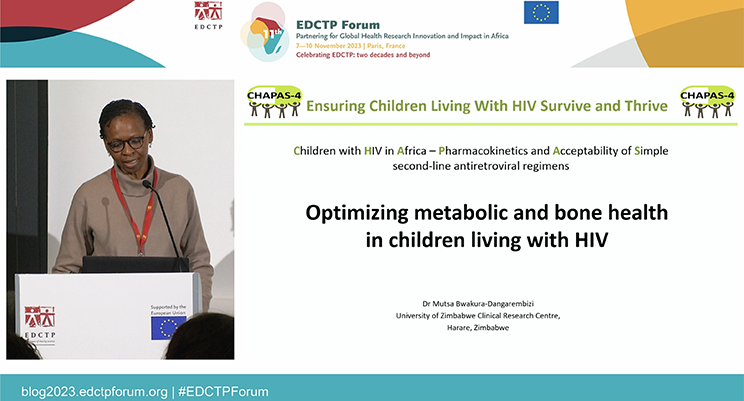The latest CHAPAS trial has generated important data on second-line antiretoviral treatments for children and adolescents living with HIV.
Since the early 2000s, the CHAPAS team of collaborators has been conducting influential studies with the overall aim of ‘ensuring that children with HIV in Africa survive and thrive’. Data are now being analysed from CHAPAS-4, which is likely to have a similar impact on policy and practice.
A Scientific Symposium at the Eleventh EDCTP Forum, chaired by Professor Victor Musiime (Uganda) and Dr Bwendo Nduna (Zambia), included an overview of the CHAPAS-4 trial by Dr Chishala Chabala at the University of Zambia. He pointed out that, as more children gain access to antiretroviral therapy and survive for longer, there will inevitably be more cases of HIV drug resistance and treatment failure, requiring a shift to second-line therapy.
Hence there is a growing need to determine the optimal second-line treatment options for children and adolescents. This is a deceptively complex issue: as well as safety and efficacy in children, other factors need to be taken into consideration, including the number of pills that need to be taken, their size, and how often they have to be taken – once daily is preferable to twice daily. Antiretroviral drugs can also have long-term complications that need to be factored in. The potential to combine treatments (for example for TB) in new fixed-dose combinations also needs to be considered.
The CHAPAS-4 trial adopted an innovative design – a two-by-four factorial design, comparing two different ‘backbone’ drugs (NRTIs) in combination with four possible ‘anchor’ drugs, giving eight combinations in total. This made the trial a highly efficient way of testing multiple new drug combinations, including those with new drug options such as dolutegravir and tenofovir-alafenamide (TAF).
Optimising metabolic and bone health in children living with HIV
Dr Mutsa Bwakura-Dangarembizi of the University of Zimbabwe discussed CHAPAS-4 studies examining impacts on metabolic traits, such as lipids, weight gain, bone mineral density and renal toxicity. These results will be an important influence on recommendations made for second-line drug treatments.
Pharmacokinetics of drugs for second-line antiretroviral therapy among children and adolescents living with HIV
Dr Hylke Waalewijn of the University of Cape Town, South Africa, summarised an extensive series of pharmacokinetics studies, including detailed ‘intensive studies’ to document bloodstream concentrations after administration and longer-term studies of antiretroviral drug metabolism. The studies have demonstrated that drug concentrations do seem to reach levels seen in adults, arguing that they will also be effective in children.
Capacity strengthening through ‘hub-and-spoke’ within-country mentoring of new research centres, and training early career researchers in Africa and Europe, leveraging on a clinical trial network
Finally, Dr Veronica Mulenga of the University of Zambia described how the CHAPAS-4 study has contributed to capacity building. Of particular note, the three main well-established recruiting sites, in Uganda, Zambia and Zimbabwe, have each paired up with a site with less trial experience, helping to build their clinical trial capabilities.
In addition, the trial has provided a framework for three master’s projects and three PhDs, while other PhD students are also making use of CHAPAS-4 data (particularly the extensive pharmacokinetics data). A wide range of other training activities have been organised, and project staff have also been able to participate as observers at Data Safety and Managing Board meetings, gaining experience of this important function.


